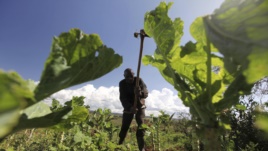VOA慢速英语:建造防风林保护农作物
Welcome to As It Is, from VOA Learning English. I’mKaren Leggett in Washington. Thanks for joining us.
Today we have two stories dealing with agriculture. Wetell about some researchers and their efforts to makelife easier for farmers in developing countries.
But first, we report on efforts to protect crops and thesoil around them. Soil conservation methods helpfarmers protect their land from the damage caused byfarming and the forces of nature. One method of soilconservation is the use of windbreaks. Bob Doughtyhas our report.
Building a Windbreak to Protect Crops
Windbreaks are barriers formed by trees and other plants. Farmers plantthese barriers around their fields.
Windbreaks help prevent the loss of soil.
They stop the wind from blowing soil away. They also keep the wind fromdamaging or destroying crops.
Windbreaks can be highly valuable for protecting grain crops. For example,studies have been done on windbreaks in parts of West Africa. These studiesfound that grain harvests were as much as twenty percent higher in fieldsprotected by windbreaks compared to fields without them.
But here is something interesting about windbreaks. They seem to work bestwhen they allow some wind to pass through the barrier of trees or plantsaround a field. If not, then the movement of air close to the ground will lift thesoil. Then the soil will be blown away.
For this reason, a windbreak works best if it contains only 60 to 80 percent of the trees and plants that would be needed to make a solid line. An easy ruleto remember is that windbreaks can protect areas up to 10 times the height of the tallest trees in the windbreak.
There should be at least two lines in each windbreak. One line should belarge trees. The second line, right next to it, can be shorter trees or otherplants with leaves. Locally grown trees and plants are considered the bestchoices for windbreaks.
Studies have shown that some kinds of trees can grow well even if the qualityof the land is not very good. One kind of tree is the white pine. Another is theloblolly pine.
Windbreaks not only protect land and crops from the wind. Surplus trees canbe cut down and used or sold for wood.
Trees reduce the damaging effects of wind and rain. Their roots help protectsoil from being washed away. And trees can provide another valuable servicefor agriculture. They can provide grazing animals with shade from the sun.
I'm Bob Doughty.
You are listening to As It Is, VOA’s daily program for people learning English. I’m Karen Leggett in Washington.
Farming without big machines is hard work. Planting and fertilizing alone cantake days in the hot sun. Researchers are working to develop simplemachines to make life easier for farmers in the developing world. They alsowould like to help the farmers save money. Christopher Cruise has more.
Simple Machines for Small Farmers
The sound you hear is Jelle Van Loon swinging a longmetal hoe with just two flat teeth. He is testing a modelof a hand-held planting tool designed for small-scalefarmers. With each stroke, one tooth plants a seed: theother, a little fertilizer.
 |
|
A farmer works in his field at the Kondo farm in Eldoret 400km (248 miles) west of the capital Nairobi, Kenya. |
Jelle Van Loon is not a farmer. He is an engineer at theInternational Maize and Wheat Improvement Center inMexico. The center is known by its Spanish name,CIMMYT.
Mr. Van Loon is working to develop low-cost tools for small scale farmersaround the world. He hopes the tools will save them work, time and money. Usually he starts with a piece of equipment built somewhere else.
“Some are Chinese-made, some are Brazilian-made, where already a lot ofeffort has been done for small-scale farmers. But the idea is to get theseimplements here, test them on the fields, and extract what works for us.”
An example is a hand-planter from Brazil. The long, wooden v-shaped toolhas a piece of metal on the bottom for breaking up the soil. Opening the armsof a part shaped like the letter V loads seed and fertilizer into the metal tip.
This tool is faster and costs less than planting by hand. It uses less seed andfertilizer. It can also reduce the time required for planting and fertilizing a two-hectare farm in half.
The planter still costs about $200 to make. But Jelle Van Loon thinks the finalproduct will cost less. But he says more work is needed. He broke the chainholding the two sides of the V part together. And the wood expanded as aresult of the tropical rain in Mexico. So the researchers changed the woodand used a stronger chain. They are now testing their fourth version of theplanter.
Mr. Van Loon says CIMMYT will publish plans for the tool on the Internet afterthe group has found what works.
“So every part is drawn and analyzed, what kind of material you have to use. And this goes to the blacksmiths locally, and to the farmers, so that both canargue what should be done.”
However, a tool may work great in one area, but not in another. This may be aresult of weather conditions, soil or other issues. So local manufacturers willhave to make minor changes to the tool based on where they plan to sell it.
From VOA Learning English, I’m Christopher Cruise.
That is As It Is, from VOA Learning English. Thanks for listening to ourprogram. Do you have a question or comment about this show? We wouldlove to hear from you. Email us at learningenglish@voanews.com. Or visitour website, learningenglish.voanews.com and click on “Contact Us.”
- 频道推荐
- |
- 全站推荐
- 推荐下载
- 网站推荐




















